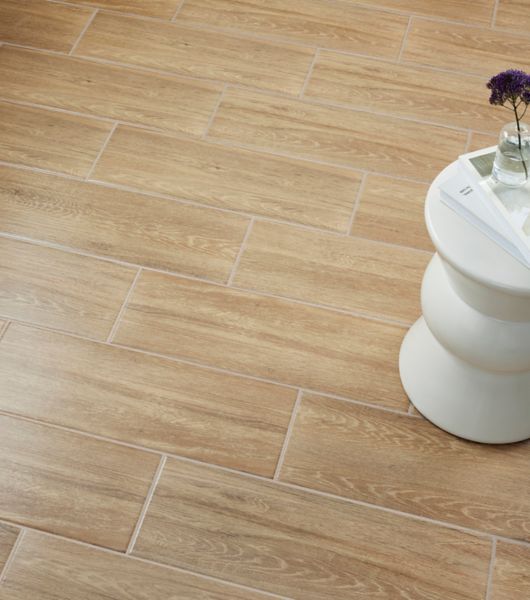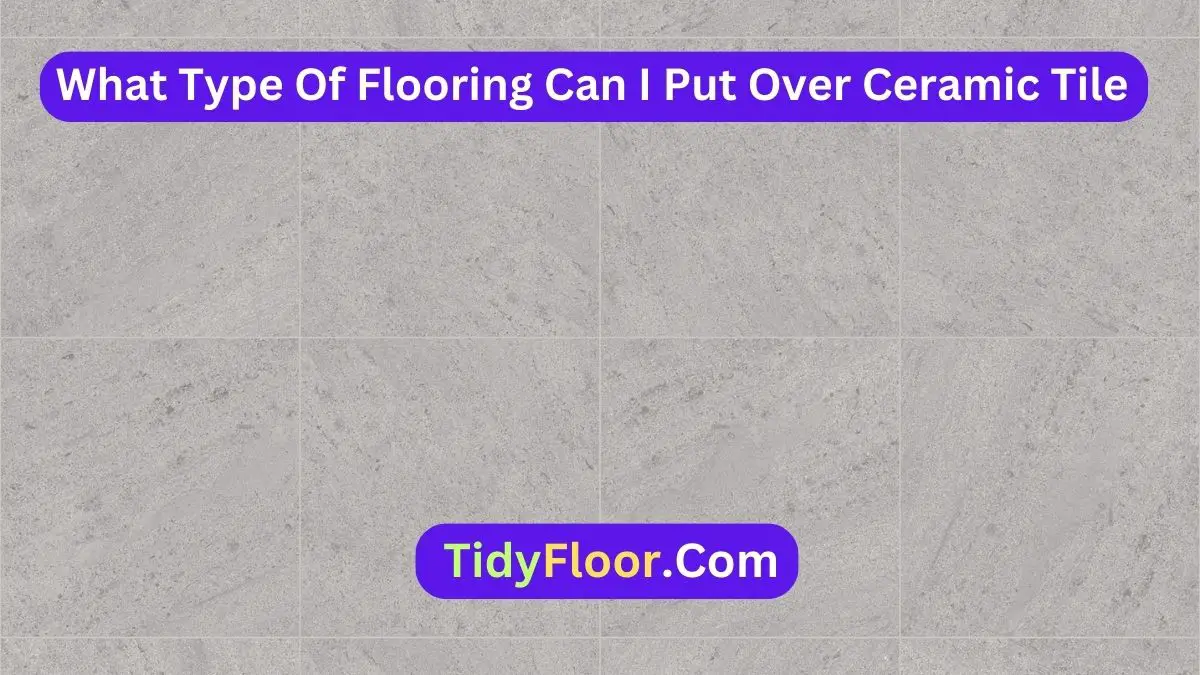Overlaying ceramic tile with new flooring offers a versatile solution to update and refresh your space. But before that, you should be aware of what type of flooring can I put over ceramic tiles.
You can put laminate, vinyl plank, engineered wood, luxury vinyl tile (LVT), carpet tiles, linoleum, or cork flooring over ceramic tile. Ensure the ceramic tile is in good condition, clean, and level before installation to ensure the best results with your chosen flooring material.
In this guide, I’ll let you know more info about the recommended types and their pros and cons. Also, for your convenience, I’ll give you insight about the considerations and some products.
6 Best Flooring Options To Put Over Ceramic Tile:

Exploring the best flooring options to place over ceramic tile opens up a world of possibilities for enhancing your living space. From the durability of laminate to the versatility of luxury vinyl tile, this guide will delve into various options.
#1- Laminate
Laminate flooring is a popular choice for covering ceramic tile due to its durability, affordability, and ease of installation. It typically consists of multiple layers, including a durable wear layer, and a decorative layer that mimics the look of wood or stone, and a core layer for stability.
Example:
Pergo Outlast+ Laminate Flooring boasts high durability and water resistance. This combination makes it suitable for areas prone to moisture like kitchens and bathrooms.
Pros:
- Affordability: Laminate flooring is often more budget-friendly than other options like hardwood or engineered wood.
- Durability: It is scratch-resistant, making it suitable for high-traffic areas.
- Variety: Laminate comes in various styles and designs, mimicking hardwood, stone, or tile.
- Easy Installation: Many laminate options feature click-lock systems for easy DIY installation.
Cons:
- Moisture Sensitivity: While laminate is more moisture-resistant than hardwood, prolonged exposure to moisture can still cause damage.
- Limited Refinishing: Unlike hardwood, laminate cannot be refinished if it gets scratched or damaged.
- Perception: Some may perceive laminate as less luxurious compared to hardwood or stone options.
#2- Vinyl plank
Vinyl plank flooring is another excellent option for covering ceramic tiles. It is known for its water resistance, durability, and ease of maintenance. Vinyl plank flooring typically comes in long, narrow strips that mimic the look of hardwood.
Example:
Shaw Floorte Vinyl Plank Flooring offers a wide range of styles, including wood and stone looks, with added durability and water resistance.
Pros:
- Waterproof: Vinyl plank flooring is highly resistant to water, making it suitable for areas prone to moisture.
- Durability: It is scratch and dent-resistant, ideal for households with pets or children.
- Easy Maintenance: Vinyl plank flooring requires minimal maintenance, usually only needing regular sweeping and occasional mopping.
- Comfortable: It has a softer feel underfoot compared to hardwood or tile.
Cons:
- VOC Emissions: Some vinyl products may emit volatile organic compounds (VOCs). It can be harmful if not properly ventilated.
- Not Eco-Friendly: Vinyl is a synthetic material and may not be considered environmentally friendly.
- Not as Natural Looking: While advancements have been made in mimicking natural materials, some may still prefer the authenticity of hardwood or stone.
#3- Engineered Wood:
Engineered wood flooring consists of a real wood veneer layer bonded to a plywood base. This construction provides the look of hardwood with increased stability and resistance to moisture.
Example:
Bruce Hydropel Engineered Hardwood Flooring offers waterproof technology and a thick veneer layer for durability.
Pros:
- Natural Aesthetics: Engineered wood offers the warmth and beauty of real wood flooring.
- Moisture Resistance: Its layered construction makes it more resistant to moisture compared to solid hardwood.
- Versatility: Engineered wood can be installed in areas where solid hardwood may not be suitable, such as basements.
- Longevity: Properly maintained, engineered wood flooring can last for decades.
Cons:
- Cost: Engineered wood flooring tends to be more expensive than laminate or vinyl options.
- Veneer Thickness: Lower-quality engineered wood may have a thinner veneer layer, limiting refinishing options.
- Sensitivity to Humidity: While more resistant to moisture than solid hardwood, engineered wood can still be affected by extreme humidity.
#4- Luxury Vinyl Tile (LVT):
Luxury vinyl tile (LVT) offers the look of natural stone or ceramic tile with the durability and easy maintenance of vinyl.
Example:
Armstrong Alterna Luxury Vinyl Tile offers a wide range of stone and ceramic tile looks with enhanced durability and easy maintenance.
Pros:
- Realistic Appearance: LVT comes in a variety of styles and designs, including realistic stone and tile looks.
- Durability: It is scratch, stain, and water-resistant, making it suitable for high-traffic and moisture-prone areas.
- Easy Maintenance: LVT requires minimal maintenance, typically only needing regular sweeping and occasional mopping.
- Comfort: LVT is warmer and softer underfoot compared to ceramic tile.
Cons:
- Installation Complexity: While LVT can be DIY-installed, some styles may require additional steps like grouting, which can increase installation time and complexity.
- Environmental Impact: Like other vinyl products, LVT may not be considered environmentally friendly due to its synthetic composition.
#5- Carpet Tiles:
Carpet tiles offer a unique and versatile option for covering ceramic tiles. They consist of individual carpet squares that can be installed over existing flooring, including ceramic tile.
Example:
Interface Carpet Tile offers a wide range of styles and designs suitable for various commercial and residential applications.
Pros:
- Versatility: Carpet tiles come in various colors, patterns, and textures, allowing for creative design possibilities.
- Easy Installation: Individual tiles can be easily replaced if damaged, making maintenance simpler.
- Sound Insulation: Carpet tiles can help reduce noise and echo in rooms.
- Softness: They provide a softer, more comfortable feel underfoot compared to hard surfaces like ceramic tile.
Cons:
- Staining: While many carpet tiles are treated to resist stains, spills can still occur and may require prompt cleaning to prevent permanent damage.
- Maintenance: Regular vacuuming and occasional deep cleaning are necessary to keep carpet tiles looking their best.
#6- Linoleum Tiles:
Linoleum tiles are made from natural materials such as linseed oil, cork powder, and wood flour. These make them an environmentally friendly flooring option.
Pros:
- Environmentally Friendly: Linoleum is made from renewable materials and is biodegradable, making it an eco-conscious choice.
- Durability: Linoleum is known for its durability and can withstand heavy foot traffic.
- Variety: It comes in a wide range of colors and patterns, offering versatility in design.
- Easy Maintenance: Linoleum is easy to clean and maintain. Typically, requiring only regular sweeping and mopping.
Cons:
- Susceptibility to Moisture: While linoleum is more water-resistant than hardwood, prolonged exposure to moisture can still cause damage.
- Initial Odor: Linoleum may emit a slight odor upon installation, although it typically dissipates over time.
What Things To Consider When Putting Flooring Over Ceramic Tile:
When considering putting flooring over ceramic tile, several factors should be taken into account to ensure a successful and long-lasting installation. Here are some key considerations:
Condition Of The Ceramic Tile:
Inspect the condition of the existing ceramic tile. Ensure it is clean, level, and free from any cracks, chips, or other damage. Address any issues before installing the new flooring to prevent problems down the line.
Height and Transition:
Adding a new layer of flooring will increase the height of the floor. Consider how this will affect transitions to other rooms or floor types, such as doorways and thresholds. You may need transition strips to create a smooth and seamless transition between different flooring materials.
Compatibility:
Ensure that the new flooring material is compatible with the ceramic tile substrate. Some materials may require additional preparation or adhesives to properly adhere to the tile surface. Check manufacturer recommendations and consult with a professional if unsure.
Moisture And Subfloor Preparation:
Ceramic tile can be relatively waterproof, but moisture can still be an issue, especially in areas like bathrooms and kitchens. Evaluate the moisture levels in the room and consider installing a moisture barrier or underlayment to protect the new flooring from moisture damage.
In addition, prepare the subfloor to be smooth, clean, and free from any debris or imperfections that could affect the new flooring installation.
Flooring Material Properties:
Different flooring materials have varying properties and requirements. Consider factors such as durability, water resistance, ease of installation, maintenance, and aesthetics when selecting the new flooring material. Choose a material that best suits the needs of the space and your preferences.
Installation Method:
Determine the best installation method for the chosen flooring material. Some materials may require adhesive, floating installation, or click-lock systems. Follow manufacturer guidelines and consider hiring a professional installer for complex or large-scale projects to ensure proper installation.
Aesthetic Considerations:
Think about how the new flooring will complement the existing decor and design of the space. Consider factors such as color, texture, pattern, and style to achieve the desired aesthetic outcome.
Budget and Cost:
Flooring projects can vary significantly in cost depending on the chosen material, quality, and installation method. Establish a budget and consider the overall cost, including materials, installation, and any additional supplies or accessories needed for the project.
8 Recommended Products To Complete The Job Properly:
To complete the job properly when installing flooring over ceramic tile, you’ll need various products and materials depending on the specific requirements of your project. Here’s a list of recommended products that are commonly used for this purpose:
1- Flooring Material:
Depending on your preference and requirements, choose the appropriate flooring material such as laminate, vinyl plank, engineered wood, luxury vinyl tile (LVT), carpet tiles, linoleum tiles, or cork.
2- Moisture Barrier/Underlayment:
If necessary, install a moisture barrier or underlayment to protect the new flooring from moisture and provide additional cushioning and sound insulation. Products like Roberts AirGuard 5-in-1 Moisture Barrier Underlayment or Schluter DITRA Waterproofing Membrane are commonly used options.
3- Adhesive/Installation System:
Choose the appropriate adhesive or installation system recommended by the flooring manufacturer. This could include adhesive for glue-down installations, click-lock systems for floating installations, or grout for tile-like flooring options.
Examples include Bostik’s Best Wood Flooring Adhesive for engineered wood or Armstrong S-288 Flooring Adhesive for luxury vinyl tile.
4- Transition Strips:
Use transition strips to create smooth transitions between different flooring materials or areas. Examples include T-molding, reducer strips, or end caps, depending on the height difference and transition requirements.
5- Flooring Tools:
Ensure you have the necessary tools for proper installation, including a tape measure, utility knife, rubber mallet, pry bar, tapping block, saw (if cutting is required), and a level. A flooring installation kit, such as the Roberts Laminate and Wood Flooring Installation Kit, can often include many of these tools.
6- Finishing Accessories:
Consider any finishing accessories needed to complete the installation, such as baseboards, quarter-round molding, or transition moldings. Choose options that complement the new flooring and existing decor.
7- Cleaning and Maintenance Products:
Purchase appropriate cleaning and maintenance products recommended for the specific flooring material. This may include specialized cleaners, polish, or protective coatings. For example, Bona Hardwood Floor Cleaner is suitable for engineered wood floors, while Rejuvenate Luxury Vinyl Floor Cleaner is designed for luxury vinyl tile.
8- Safety Equipment:
Don’t forget about safety equipment such as gloves, safety glasses, and knee pads to protect yourself during the installation process.
Related Questions
DIY Or Hire A Professional: Which One Would Be Best For You To Put Flooring Over Ceramic Tile?
Whether to undertake a DIY flooring project or hire a professional depends on factors like your skill level, time availability, and the complexity of the job. DIY can save costs, but requires proper tools, knowledge, and patience. Professionals offer expertise that ensures proper installation and potentially saves time and stress.
For complex or large-scale projects, hiring a professional might be best to achieve desired results efficiently and with fewer risks of errors. Assess your capabilities and project scope carefully before deciding.
What Are The Biggest Challenges Of Overlaying Ceramic Tile?
Overlaying ceramic tile presents challenges such as ensuring proper adhesion of the new flooring material, addressing height differentials between rooms, and managing transitions between flooring types. Proper preparation of the ceramic tile surface is crucial to prevent issues like unevenness or delamination.
Also, managing moisture levels and ensuring compatibility between the existing tile and new flooring material are important considerations. Careful planning and attention to detail are necessary to overcome these challenges and achieve a successful overlay.
Where Can You Find More Information And Specific Installation Guides?
For detailed information and specific installation guides, you can consult manufacturer websites, home improvement stores, or online resources. Many flooring manufacturers provide comprehensive installation instructions and videos on their websites, along with product specifications and recommendations.
Also, home improvement websites like Home Depot, Lowe’s, or This Old House offer step-by-step guides, tutorials, and forums where you can find advice and tips from professionals and fellow DIY enthusiasts.
Final Verdict For What Type Of Flooring Can I Put Over Ceramic Tile
If you’re considering updating your flooring by overlaying ceramic tile, it’s essential to understand the process and potential challenges involved. You can achieve the desired aesthetic and functionality by implementing the best options among the types. Also knowing the considerations, and recommended products can help you to get the desired results.


